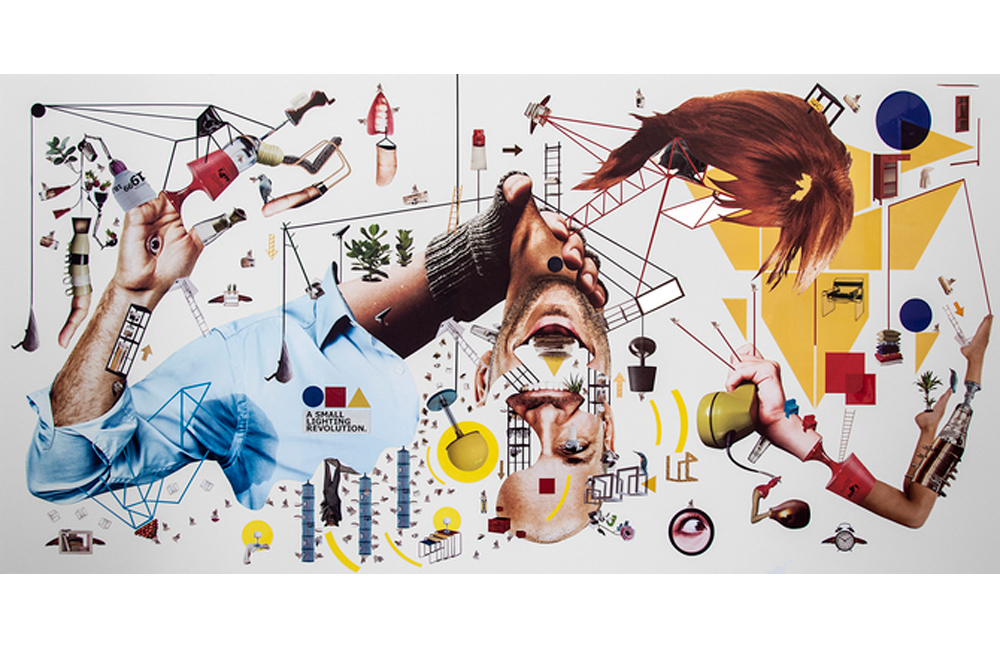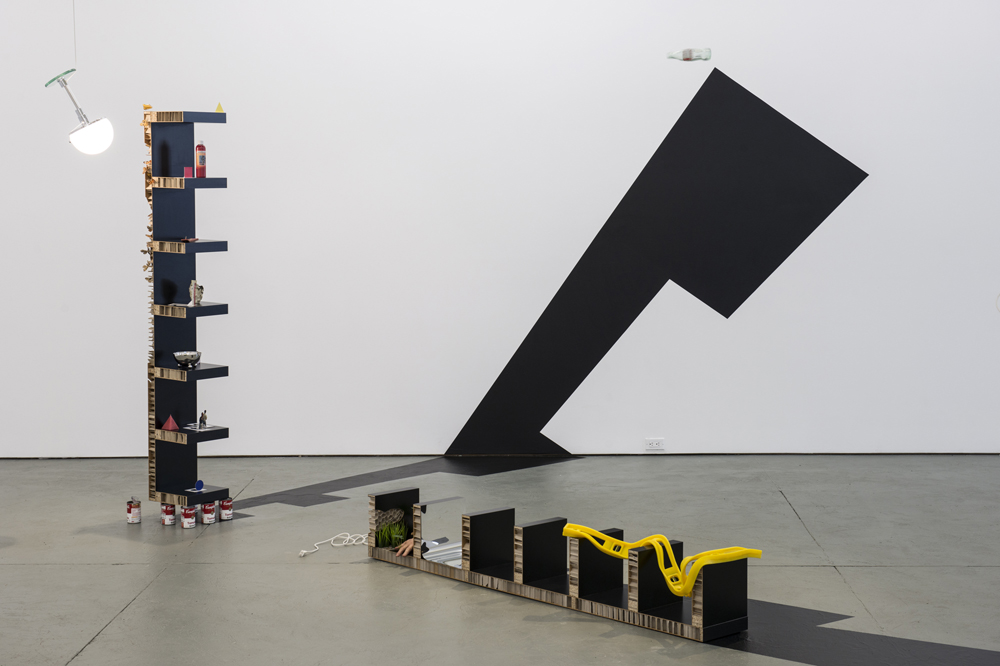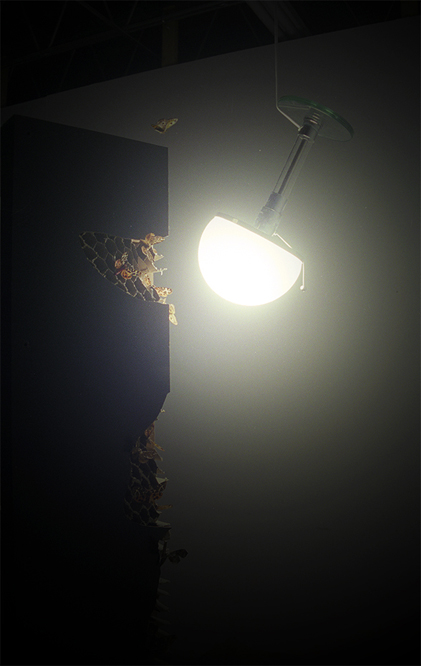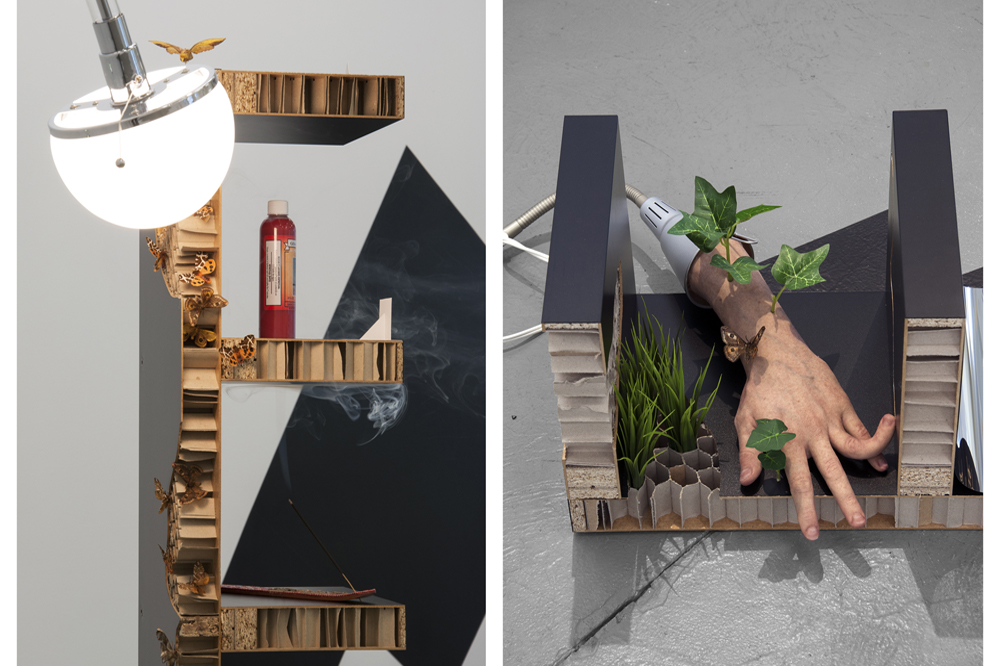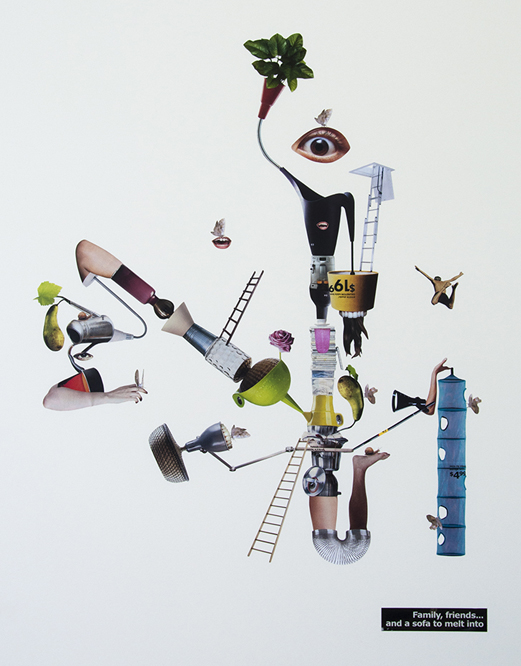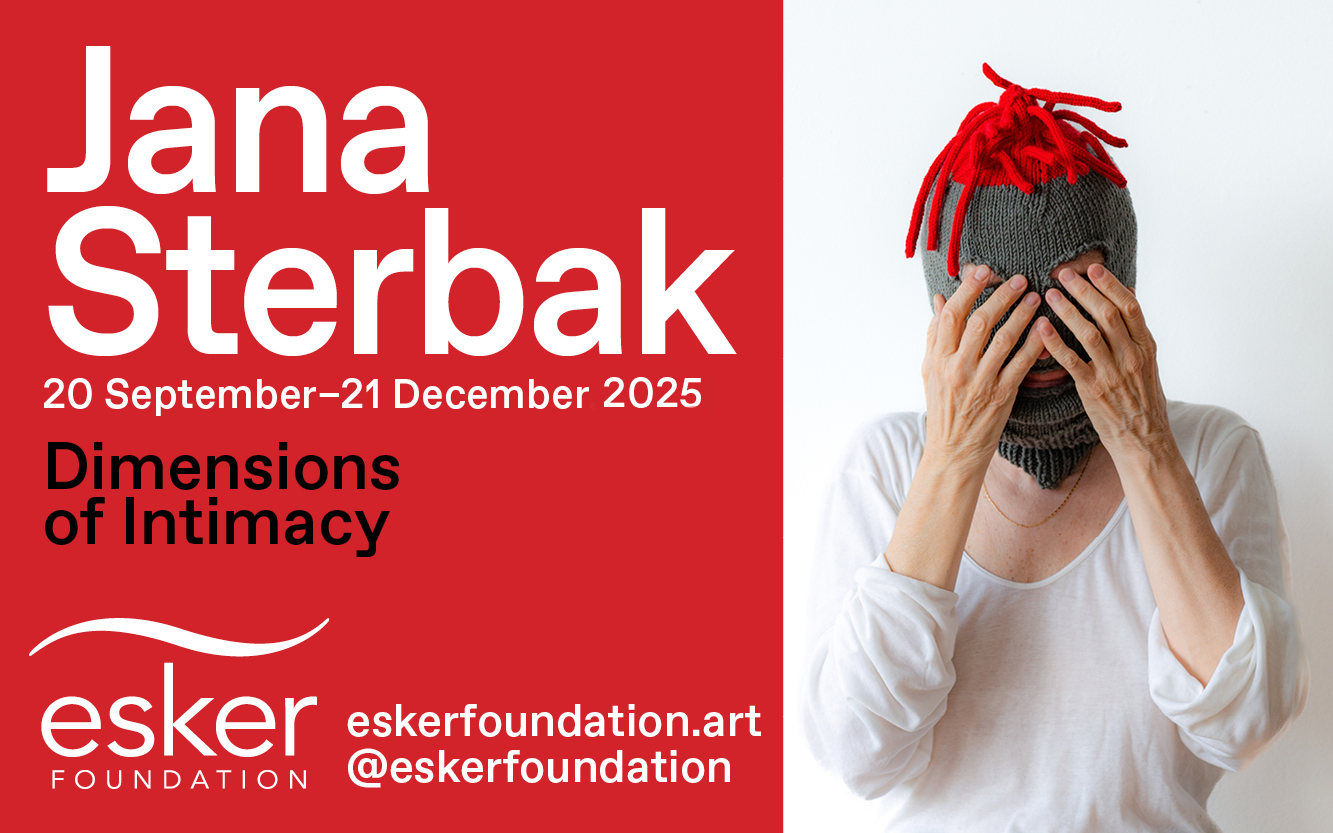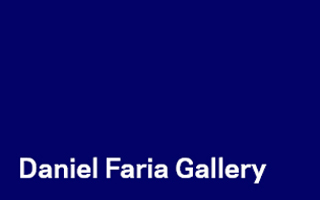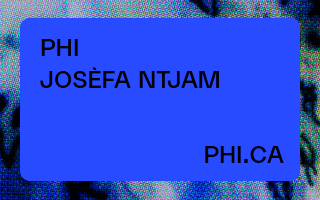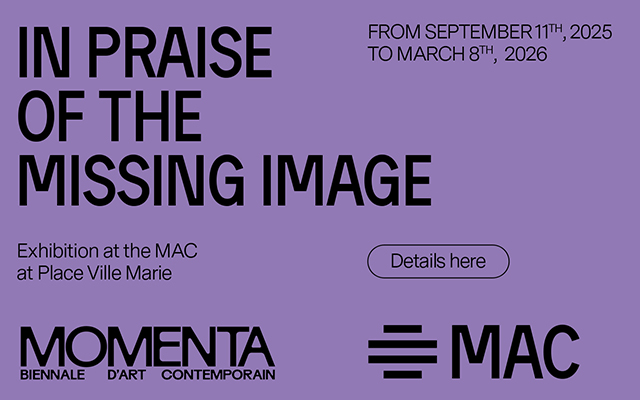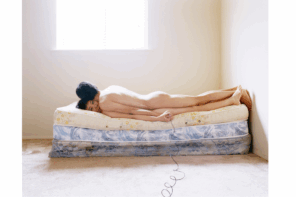Entering Juan Ortiz-Apuy’s Out of This Light, Into this Shadow, his second solo exhibition at galerie antoine ertaskiran, the first thing that strikes me is the pungent fragrance of incense. The burner (continually replenished, I’m told) sits on a freestanding Ikea Lack shelf that also holds a number of other kitsch devotional items of varying totemic significance. Among them, you can find a bottle of filmy red liquid labeled “Go Away Evil Mystic Bath,” a vial of “Spell Breaker” potion next to a mirrored bowl, cut-out photos of kneeling humans next to a pink wax pyramid, and a metallic crystal beside two miniature images, snipped from an IKEA catalogue, of the Lack unit itself. It retails for $49.99 – a Donald Judd facsimile that anyone can afford.
The whole unit is propped up on Campbell’s soup cans, a nod to the twinned legacies of Pop Art and Minimalism – high-art’s first forays into the serial, industrial aesthetics of mass production. Nearby, a toppled-over double of the upright Lack unit lies on the floor, with the words “From Bauhaus to Our House” (borrowed from Tom Wolfe’s 1981 critique of modern architecture) hand-carved from its surface. From only a few steps into the space, then, Ortiz-Apuy has provided you with a vanload full of thematic components and, if not a manual for assembly, at least an idea of what the parts might add up to: a fantastical story, replete with magic and animism, that recounts the fate of minimalist design aesthetics from the utopianism of the Bauhaus to the banality of IKEA.
The two pieces of furniture also continue Ortiz-Apuy’s investigation – ongoing through his last several exhibitions – of sculpture as a display and support structure, “something to put something on,” in the words of a Lawrence Weiner book that Ortiz-Apuy cites as an inspiration. The whole of the sculptural installation that bears the exhibition’s title is this kind of “something” and Ortiz-Apuy has put a great many things on (or in) it. The fallen Lack unit supports a rubber spirit level (a quasi-surrealist parody of both Bauhaus and Minimalist geometry) while an empty Coca-Cola bottle hovers a few feet above head level, spinning rapidly, anchored by a long cord to a fake rock (sitting on a tiny fake meadow) that hides a speaker inside, emitting a quiet, thrumming ambient soundtrack. Each of the items in Ortiz-Apuy’s cabinet of curiosities catches the eye (or the nose, or ear) in its own way, but each also acts as a unit in a larger system of meaning that only becomes apparent in the course of your ricochet between the interconnected matrix of objects, images, and references on offer.
The density of Ortiz-Apuy’s web of signifiers can be dizzying. Consider one of his older works, not included in this show: A Map of the Empire of Language as a Place of Struggle, a print that Ortiz-Apuy produced to accompany his solo exhibition at the MacLaren Art Centre in 2011. At a glance it will confirm that the artist is not only exceptionally well-read, but also that his sensibility is deeply informed by literature, especially writing concerned with the organization of knowledge and the power of language to legislate reality. Jorge Luis Borges and Georges Perec loom large in Ortiz-Apuy’s cosmology, but his interest in experimental and magic-realist fiction isn’t merely academic – it also derives from his experience as a Costa-Rican-born artist living in French Canada. For him, language is a political issue and literature has been a means to address the legacy of colonialism, the experience of post-colonialism, and the reality of globalization. For example, Waiting for the Barbarians, Ortiz-Apuy’s 2013 solo show at antoine ertaskiran, was loosely about the circulation of goods, money, and people around the globe, and the forces that determine how and where our mobility flows (or doesn’t): inflation, borders, and security all become sculptural terms.
Like Felix Gonzales-Torres, Ortiz-Apuy has a deft facility for individual gestures, often very simple, that evoke emotive, multi-layered associations. But he also has an opposing tendency towards the gesamtkunstwerk, in which each element in his exhibitions plays off the others, fusing into a more baroque assemblage engorged with semiotic excess. (In this respect, and a few others, his work resembles Geoffrey Farmer’s.) If this approach has shown a weakness, it might be that, for all their complexity, Ortiz-Apuy’s installations have sometimes made a little too much sense, have been too “on-the-nose,” overdetermined by the artist’s own fastidious plotting of intertwined references and conceptual connections.
The scent of incense in Out of This Light, Into This Shadow, however, signals a shift in Ortiz-Apuy’s practice towards a slightly more intuitive and organic approach. Rather than taking maps as his active metaphor, he’s turned to growth and cross-pollination. Furthermore, this show presents a new formal direction. In addition to the titular sculptural installation, Out of This Light includes a series of six collages (five poster-sized and one truly large work, over eight feet in width), composed of cut-up and re-composited IKEA catalogues (all made in 2014). The theme driving these pieces is what Ortiz-Apuy calls the “bad dream of modernism,” the persistence of “primitive” elements of magic and animism, fantasy and unreason, within commodity culture. In other words, it’s about fetishism.
The bad dream that Ortiz-Apuy has in mind is the fate of modernist design aesthetics, especially the utopian program of the Bauhaus, whose pioneers dreamed of democratizing design and modernizing space by simplifying form, eliminating decoration, and revealing function. The Bauhaus aimed to rationalize the entirety of everyday life but, as it turned out, ubiquitous design meant universal commodification. IKEA represents the mass-market terminus of art’s encroachment on life, its conversion of utopian urbanism into the big-box shopping complex. (Another of Ortiz-Apuy’s key references for this exhibition is Hal Foster and Rem Koolhaas’s notion of “Junkspace,” the extension of junk food to the built environment).
To tell the tale of this fall from grace, Ortiz-Apuy employs two characters, who return us to that freestanding IKEA Lack shelf. For one thing, the unit is illuminated by a light fixture that hangs upside-down from the ceiling – specifically, a 1924 Bauhaus lamp designed by Wilhelm Wagenfeld and Carl Jacob Jucker. It’s among the Bauhaus’s most iconic designs, exemplary of the school’s philosophy of minimal, modern form. Here, the lamp is a figure in a more eccentric drama of Ortiz-Apuy’s invention. The “light” of the Bauhaus – their inspiration, idealism, and influence – takes on the role of a weird radiation, the agent of uncanny and sinister transformations. Hence, also, the “shadow” of the show’s title, representing the negative fallout of Bauhaus innovation, which is literally figured by jagged painted shadows that extend off of Ortiz-Apuy’s IKEA units.
Ortiz has also cut away the sides and back of the IKEA shelf, revealing that the surface is deceptive – its interior is not solid, as it appears, but a honeycomb of flimsy cardboard. Among its shadowy recesses, Ortiz-Apuy has secreted the lamp’s counterpart character: moths. They’re real, too, dozens of them, all meticulously hand-mounted. These creatures of the night (yet attracted to light) are revealed as the inhabitants of the void within the commodity-object, a swarming, unwholesome life that dwells beneath the clean and minimal surfaces of lifestyle marketing.
Both the lamp and the moths reoccur throughout the exhibition. An archival photo of two early versions of the Wagenfeld lamp is mounted in a flickering lightbox at knee-height in a corner of the space – from a distance, I took it for a picture of two mushrooms. Another lightbox on the other end of the gallery displays a photo of Ortiz-Apuy’s signature lamp hovering in semi-darkness near the edge of the cut-away shelf, seemingly summoning the moths into being.
Even more lamps and moths proliferate among Ortiz-Apuy’s collages, which are among the most straightforwardly pleasing works he’s ever produced. Given that so much of his art rests on selection and juxtaposition (cut-and-paste being perhaps the most universal operation in art-making today), it’s remarkable that it took Ortiz-Apuy so long to break out the old-fashioned glue and scissors. As far as “something to put something on” goes, there’s no more venerable display structure than the picture plane.
In these works, the themes of the exhibition reach peak legibility. In one titled Organic Minimalism (all the titles are actual IKEA slogans, clipped-out and applied to the page), a series of LeWitt-like cube structures unfold alongside a set of nested tables, as yellow-haloed Wagenfeld lamps attract moths, and an extended Lack unit towers upward like Brancusi’s Endless Column, topped with a Day-of-the-Dead skull. In Cubique et Magique, a figure in a metal mask (lifted from a Bauhaus photo in which it was worn by a woman modeling a futuristic chair) slumbers within an exploded view of furniture assembling and disassembling itself around our protagonist. A Bedtime Story That Lasts the Whole Night offers a jaunty fusion of humans and houseware, as a night-table full of books sprouts a multi-limbed, anthropomorphic appliance with protruding ladders, plants, and facial features.
The centerpiece, however, is A Small Lighting Revolution, which offers a hermetic, diagrammatic complexity akin to Picabia’s man-machine hybrid drawings, or even to Duchamp’s Large Glass, reconfigured as a mail-order catalogue. In the lower portion, a cascade of books fall under under the mutagenic glow of a battery of Wagenfeld lamps and turn into moths, which then nest in IKEA closet organizers alongside a bat. In two separate places, the bulk of the nonsensical human/appliance armature in the picture is supported by a man sitting in a sling chair, reading.
On the one hand, these images are a parody of literacy, an image of modernist rationality mutating into its opposite. But it’s also easy to see them as a portrait of the artist and his working methods. Ortiz-Apuy seems to amass books in order to irradiate them with his own sensibility until they begin transforming into sculptural matter. His personal notebook is on view in the gallery as part of the exhibition’s supplementary materials, and in it, you can find over a hundred pages of meticulous notes on dozens of sources: books on the Bauhaus, catalogues of contemporary sculpture exhibitions (Unmonumental, The Uncertainty of Objects and Ideas), monographs on other artists (Isa Genzken, Geoffrey Farmer, David Altmejd, Richard Serra, Sarah Sze), essays on animism and appropriation, Baudrillard’s For a Critique of the Political Economy of the Sign, and no fewer than four texts by Hal Foster.
Unlike many others working in the genre of “precarious” junk and assemblage sculpture – Genzken, for instance – Ortiz-Apuy seems less concerned with the materiality of junk or makeshift accumulation itself than he is with keeping meaning in play, letting associations spread out and circulate within a dispersed (if still coherent) system. I see this as a sign of his fundamentally literary orientation. His ideal viewer is really a reader, so what he’s doing is spatializing concepts, building a mental architecture. Ultimately, every Ortiz-Apuy exhibition is a kind of fantasy library, like Borges’s Tower of Babel. They’re easy places to get lost, but you never run out of reading material.

